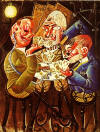100 Greatest Painters Artists Alphabetically Artists by Country Artists by Century Artists by Movement
"Entartete
Kunst" - Degenerate Art
Example of paintings condemned and called Degenerate by the evil Nazis (click to Enlarge)
The years 1927-37 were alarming and terrifying for artists in Germany. In 1937 The National Socialist Society for German Culture held an art exhibition in Munich. The Nazis called the exhibit Entartete Kunst, or Degenerate Art. During this time over 22 thousand art-works by more than 200 modern avant-garde painters of that time were confiscated. Hitler declared "It is not the mission of art to wallow in filth for filth's sake, to paint the human being only in a state of putrefaction, to draw cretins as symbols of motherhood, or to present deformed idiots as representatives of manly strength."
The National Socialist Society for German Culture declared artists of the banned paintings, mostly Expressionists, Cubists, Dadaism, Surrealist, Fauvists, nineteenth-century Impressionist and Post-Impressionist to be insane and morally corrupt madmen.
Goebbels launched a vicious campaign ordering avant-garde artists residing in Germany not to paint.
Particularly reviled were some of the greatest painters of the time; Edvard Munch, Emile Nolde, Ernst Kirchner ( Kirchner was so devastated by his exile to Switzerland that he committed suicide in in 1938.) Wassily Kandinsky, Otto Dix, Franz Marc, Paul Klee, Klee feared for his life and spent his years cast out in Switzerland. The artist unable to obtain Swiss citizenship because of his status as a degenerate artist. The Nazis felt that these artists led young people astray and encouraged corrupt ideas. The upper echelons of the SS occasionally got together for 'art burning' parties. They would drink beer and throw darts at so called degenerate paintings, later burning the paintings in huge art pyre.
The justification for deciding on what could be classified as "degenerate" art was relatively straightforward and spiteful: any painting or sculpture that was in conflict with Hitler's artistic philosophy, was considered to be "Entartete Kunst". Hitler asserted "Theater, art, literature, cinema, press, posters, and window displays must be cleansed of all manifestations of our rotting world and placed in the service of a moral, political, and cultural idea."
Hitler preferred realistic genre painting, especially landscapes with windmills and beasts in the field. Many historians believe Hitler despised the artists of his day because he was never recognized for his own uninspired, lackluster paintings.
In the late 1930s, Joseph Goebbels, Minister for Public Enlightenment, had his minions scour German museums and private collections in search of modern, non traditional, avant-garde art-works. From the thousands of works confiscated, 650 were chosen for a special exhibit called Entartete Kunst (Degenerate Art). The exhibit opened in Munich and then traveled to dozens of other cities in the region. The curators purposely hung the paintings askew with scribbled hand written labels in the hopes that the public would view the artists and their creations in a bad light. Millions of visitors attended these sham exhibitions. The purpose of the exhibition was to show the public the stupidity, immorality, and depravity of the modern art movement. Hitler declared, "By the skillful and sustained use of propaganda, one can make a people see even heaven as hell or an extremely wretched life as paradise."
Main Artists on the The Nazi List .... singled out for special criticism.
Otto Dix German
1862-1942 Expressionist
Vincent
van Gogh Dutch,
1853-1890 Post-Impressionist
Max
Beckmann German,
1884-1950 Expressionist
Edvard
Munch Norwegian,
1863-1944 Symbolist/Expressionist
Emile
Nolde German,
1867-1956 Expressionist Painter
Ernst
Kirchner German,
1880-1938 Expressionist Painter.
Wassily
Kandinsky Russian,
1866-1944 Expressionist Painter
Paul
Klee Swiss
1879-1940 Swiss Expressionist Painter
Franz
Marc German,
1880-1916 Expressionist / Fauvist
Popular Questions About Art History
How did African art and artifacts impact modern art?
How did Raphael die?
What was the impact of Japanese Prints on Post Immpressionist painters in the late 19th century?
What is the difference between Italian Renaissance art and Northern Renaissance art?What was impact of iconoclast?
How did the Black Death impact European art history?
What was the influence of Classical humanism on the Renaissance?
How did the Inquisition impact European art history?
What was the influence of the Medici Academy on Renaissance painters?
How did the Bonfire of the Vanities impact Italian Renaissance"
What is Sfumato?
☼☼☼☼☼
If you feel you have worthwhile information you would like to contribute we would love to hear from you. We collect essential biographical information and artist quotes from folks all over the globe and appreciate your participation. When submitting please, if possible, site the source and provide English translation. Email to historyofpainter@gmail.com
© HistoryofPainters.com 2017
Copyright © historyofpainters.com.



